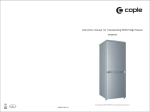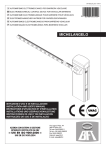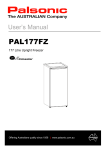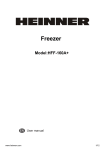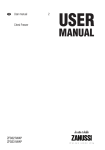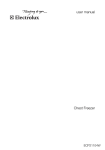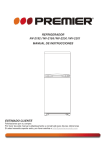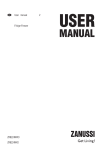Download Instruction Manual
Transcript
RoHS CKCP-A01-D · Ç ¹ Ê Õ Ï Ï Ö Ï ó Note: During the period of high relative humidity, moisture may form on the surface of the refrigerator. This is not a malfunction. You may just wipe it up. If your refrigerator is still not functioning properly after making the above checks please contact the maintenance service department without delay. Technical Specifications: * For the detailed specifications please refer to the nameplate at the back of the refrigerator. CONTENTS Appliance Illustration ---------------- 2 Instructions for Installation---------- 3 Cautions for Safety------------------- 4 * The specifications are subject to change without prior notice due to product improvement. Operation------------------------------ 4 Cleaning and Maintenance------------6 Troubleshooting----------------------- 7 Technical Specifications--------------8 · Please read this Instruction Manual before use · Due to product development, your refrigerator may not be consistent with this user manual fully. 8 1 Cautions Instructions for Installation · When defrosting, never use sharp or metallic objects to remove the frost on the surface of the evaporator, as this will cause damage. · Do not store bottled beverages in the freezing compartment, to prevent it being 1. Do not tilt the refrigerator more than 45o from upright when moving it. Avoid collision and violent vibration during transit. Do not apply force to any part such as condenser, the door or its handle in order to prevent damage as performance may be affected. broken and causing damage. · Keep space between the food packets to allow the cold air to circulate smoothly in the fridge or freezer compartment. Cleaning and Maintenance: 1. When cleaning the refrigerator, disconnect the power cable. 2. Ensure that there is enough space around the refrigerator for correct functioning and circulation. Rub carefully with a piece of cloth soaked with neutral cleanser, then wipe it clean with fresh water. Do not wash the refrigerator with water directly to prevent the unit from rust and breakdown. 3. The refrigerator should be kept away from high temperatures, direct sunlight and humid conditions. 2. Never use acids, chemical solution, thinner, gasoline or similar to clean the refrigerator because they may damage the painting cover and plastic parts of it. Detergent 4. The refrigerator should be placed on a solid floor. 3. Once or twice a year dust the compressor at the back of the appliance with a brush or vacuum cleaner, as an accumulation of dust will affect the performance 5. For your safety and protection, this unit is grounded through the electrical plug when plugged into a wall outlet. If you are not sure whether your wall outlet is properly grounded, please consult a qualified electrician. of the appliance and cause excessive electricity consumption. 6 3 Cautions for Safety 2. The temperature of the refrigerator can be adjusted by turning the thermostatic 1. The voltage should be the same as the rated voltage before the refrigerator is used. 2. The power plug should have its own separate socket in order to prevent the dial, setting the dial at 3 or 4 is the most suitable for general operation. The refrigerator capability is stronger as the dial number increases. When you set it to 0, the refrigerator will stop. electric wire from being overheated by other plugs. 3. Do not allow children to tamper with the controls or play with the appliance. 4. Do not hang heavy objects onto the door of the product to avoid the refrigerator turning over. 3. Do not put too much food in the refrigerator. Open the door less to maintain the temperature of the refrigerator and always leave warm food to cool to room temperature before putting into the refrigerator to save energy consumption. 5. It is dangerous to alter the specifications or attempt to modify this product in any way. 6. Do not place sealed containers or carbonated liquids such as fizzy drinks into the freezer as it creates pressure on the container, which may cause it to explode and cause injury or damage. 7. Do not splash water on the refrigerator. This may cause malfunctions or electric shock. 8. Do not store flammable materials such as alcohol, gasoline, LP gas or glue in the refrigerator. 9. Ice cubes and ice lollies should not be consumed immediately after removal from the freezer as it may result in low temperature skin abrasions. 10. When you change the light bulb or when the refrigerator is not in use for long periods, disconnect it from the electricity supply. 11. Wait for 5 minutes before restarting the unit after a power supply blackout. 4. Frost in the fridge compartment can defrost automatically and the water can flow to the water collection pan, which supports the compressor. The condensed water will evaporate with the heat of the compressor. If the drain hose in the compressor compartment is not installed correctly, please install it again before use. Defrost the freezer compartment whenever the layer of frost on the surface reaches 3 or 4mm. When defrosting, remove all food, set the thermostatic dial at 0 and open the door. After the frost has melted, discard the water and dry the interior of the refrigerator. The refrigerator can then be restarted by turning its thermostat to the desired setting. Operation 1. When operating the refrigerator for the first time, set the thermostatic dial at 3, connect the electric wire and run it without loading any food. Usually this takes 2-3 hours. Then set the thermostatic dial to the desired setting and place food in the refrigerator. 4 5 General: Troubleshooting: It uses a high efficiency compressor and classic structure distribution. It has the advantage of low energy consumption, driving freezing capability and easy use. 1. When the refrigerator does not operate ensure that: · The electric power is supplied and the voltage is normal · The fuse has not burnt out · The power plug is firmly plugged into the socket · The thermostat setting is not in 0 position Appliance Illustration: 2. When the refrigerator is not cool enough, ensure that: · The thermostat is at the correct setting · There is enough space around the refrigerator · The doors are not opened too frequently and for too long Thermostat · The refrigerator is not in direct sunlight or placed near a heat source · There is not too much food or hot food in the refrigerator Shelf Bracket 3. When the food in the refrigerator is frozen check that: Drain Port · The thermostat is at the correct setting Crisper Cover · There is not too much food that contains a lot of moisture in the refrigerator Crisper 4. When the refrigerator operates too noisily, ensure that: · The refrigerator is properly leveled · The refrigerator is not touching objects around it · The containers or solid packages stored inside are not touching each other Freezing Drawer Gasket 5. When there is water spill on the ground: · The drain hole is blocked Drain hose (Back) · The drain hose in compressor compartment is not installed correctly 6. When the refrigerator runs continuously in the summer without stop: Compressor (Back) · There is too much food in the refrigerator · The thermostat dial is at a higher position such as 7 Leveling Feet · The door of refrigerator is opened too frequently · The ventilation around the refrigerator is not sufficient · The door is not closed properly or the door gasket is deformed Note: This illustration is only for guidance. 2 7





